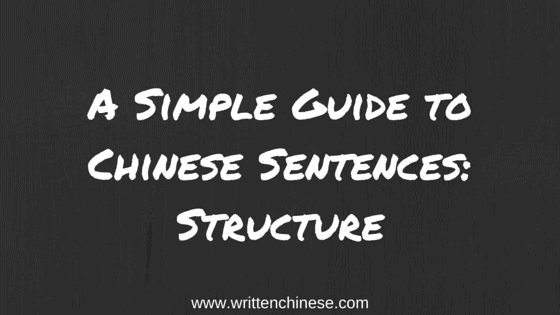A Chinese sentence may be either a simple sentence or a complex sentence, made of more than 2 simple sentences. To begin with, let’s talk about simple sentences and the components that make them:
Simple Sentence Pattern
A simple sentence will usually include at least two parts, the subject, and predicate. A common sentence structure is in three parts: subject + predicate (verb) + object.
Unlike English, most of the time in a simple Chinese sentence, the predicate is a verb, although sometimes it can be an adjective. For this guide, we will refer to the predicate as a verb, unless stated otherwise.
This is known as the trunk of a simple sentence.
Trunk Examples
(我) 的妈妈 [已经] 去 <过> (你) 的学校了。 My mother has been to your school.
The trunk of this sentence is:
妈妈 + 去 + 学校
subject + verb + object
Simple sentence components
Although subject + verb + object is the main part of a sentence, simple Chinese sentences can be made up of the following 6 components:
Subject 主语 (zhǔ yǔ): a person or thing that is being discussed, described, or dealt with.
Predicate 谓语 (wèi yǔ): part of a sentence containing a verb that relates to the subject.
Object 宾语 (bīn yǔ): a noun governed by a verb.
Attributive 定语 (dìng yǔ): modifies an adjective or noun.
Adverb 状语 (zhuàng yǔ): modifies or qualifies an adjective, or verb expressing a relation of place, time, circumstance, manner, cause, degree, etc
Complement 补语 (bǔ yǔ): complete the meaning of the predicate (verb).
Simple Sentence Examples
Subject + Verb + Object
The subject, predicate (verb) and object are the major components of every sentence.
我爱他 (wǒ ài tā) I love him
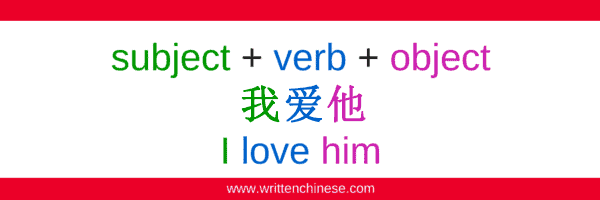
Subject + Adverb + Verb + Object
我只爱他 (wǒ zhǐ ài tā) I only love him
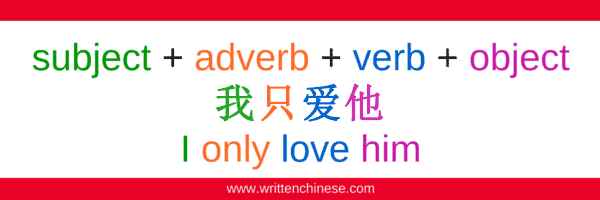
Subject + Adverb + Verb + Attributive + Object
我只爱我记忆中的他 (wǒ zhǐ ài wǒ jì yì zhòng dì tā) I only love my memories of him.
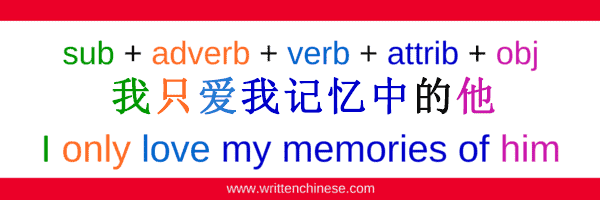
Subject + Adverb + Verb + Complement + Object
我以前爱过他 (wǒ yǐ qián ài guò tā) I loved him before.
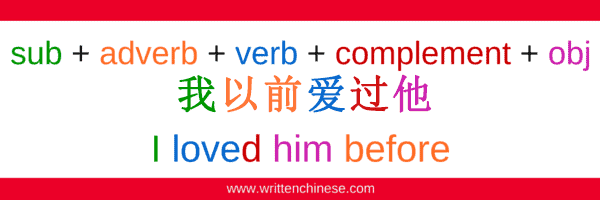
Sentence Order
Let’s look at a simple Chinese sentence in more detail and break down each component and how to use them.
The following sentence shows all 6 components in the correct sentence order:
(Attrib) Subject [Adv] Verb (Attrib) Object.
Chamcen told me that When she was at school, the teachers taught the students to separate each component using mathematical equations to help them remember each part of the sentence.
Here are the symbols they used:
Subject (主语) with ‘ = ‘
Predicate/Verb (谓语) with ‘ – ‘
Object (宾语) with ‘ ~ ‘
Attributive (定语) with ‘ ( ) ‘
Adverb (状语) with ‘ [ ] ‘
Complement (补语) with ‘ < > ‘
Here is an example of a sentence using the symbols to separate each component:
Note that auxiliary words 助词 (zhù cí) such as “的, 地, 得, 着, 了, and 过” are not marked as sentence components.

新鲜的水果不断地从国外送进农贸市场。(xīn xiān de shuǐ guǒ bù duàn de cóng guó wài sòng jìn nóng mào shì chǎng.) The fresh fruit has been sent to the farm products market continuously.
Here’s a breakdown of each component in this sentence:
Subject ‘ = ‘ is sb/sth stated. In the eg, it is 水果 (fruit).
Predicate ‘ – ‘ is action. In this eg, the verb is 送 (sent).
Object ‘ ~ ‘ is sb/sth that the action affects. In the eg, the object is 市场 (market).
We will now look at attributives, adverbs, and complements in more detail:
Attributives in Chinese Sentences
An attributive ‘ ( ) ‘ is an additional component of the subject (主语) and object (宾语) to modify. In this eg, the attributives are 新鲜 (Fresh) and 农贸 (farm trader).
The position of such attributives should be before the subject, in this case, 水果 (fruit), and the object, which is 市场 (market).
Between the attributive and the subject and object, is the ‘的’ particle. 的 is the mark of an attributive, although the ‘的’ particle is not used for some attributives.
Examples of attributives with the 的 particle
(美好)的时光总是过得很快。 ( (měi hǎo) de shí guāng zǒng shì guò de hěn kuài.) Good times always go by quickly. (Time flies when you’re having fun)
(桌子上)的花开了。( (zhuō zi shàng) de huā kāi le) The flowers on the table blossomed.
An example of attributives (without 的)
他喜欢上了(那个)(红头发)女孩。(tā xǐ huan shàng le (nèi gè) (hóng tóu fa) nǚ hái.) He is falling in love with that red-haired girl.
Adverbs in Chinese Sentences
Adverbs ‘ [ ] ‘ are additional components of a predicate (clause with a verb), used to modify the verb.
The position of the adverb should be before the verb. Generally, the adverb is between the subject and the verb, but sometimes it can be placed before the subject.
Between the adverb and verb, there is sometimes a 地 (de) particle. 地 modifies the adverb to become ‘ verb + ly ‘.
Adverb Examples
他[快速]地打开了盒子。(tā kuài sù de dǎ kāi le hé zi.) He opened the box quickly.
他[总是]写信给我。(tā zǒng shì xiě xìn gěi wǒ.) He always wrote letters to me.
Complements in Chinese Sentences
A complement ‘ < > ‘ is another component of a verb and is mostly used for explanations.
The complement should be after a verb or an object.
Complement Examples
学生们绕着操场跑了<五圈>。(xué sheng men rào zhe cāo chǎng pǎo le wǔ quān.) The students ran 5 laps around the playground.
我已经吃<完>晚饭了。(wǒ yǐ jīng chī wán wǎn fàn le)I have already finished my supper.
鸟儿自由地飞翔<在蓝天中>。(niǎor zì yóu fēi xiáng zài lán tiān zhōng.) The bird flew freely in the blue sky.
Test Your Understand of Chinese Sentence Structures
Exercise 1
Use = – ~ () [] <> to mark the sentence components:
所有同学都做完了数学作业。
Exercise 2
Find the trunk of the sentence:
这位美丽的女士是我们医院著名的牙科医生。
This beautiful lady is a famous dentist in our hospital.
Post the answers to the exercises in the comments below and we’ll give you the answers shortly!

